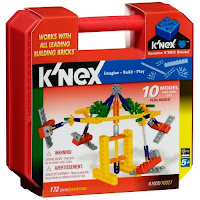All in all, I would have to say that this model went together somewhat badly. The instructions were unclear, and in at least one area, a substructure simply will not fit in the manner the computer-generated instruction images depicted. For the final step of connecting the major subassemblies into the final beast, I had to study the diagram with a magnifying glass to work out where to connect what. I probably would have been happier if I had started using the magnifier earlier.
And once it is together, it turns out that when you raise the tail, the mouth closes.
Half unit length steps can be achieved with existing parts by using round red hub/pulley element as a beam extender, though a new part with square cross section to match the beams would be welcome. (Why does Engino call the common yellow structural elements rods? It is technically incorrect and tends to suggest a K'nex inspiration for development of the Engino system. They are more like box girders. I'll stick to calling them beams.)
The quarter-unit adjustability of the expandable component could be achieved more elegantly with a 3/4 unit beam, if it is actually necessary at all (it would violate the educationally sound length-doubling sequence of the other parts - which of course the adjustable component already does). There is enough clearance in the single unit beam to allow a shortened version, though providing enough flex for easy connecting and separation might require some creative modification of the slot - perhaps a lollipop shape?
Of course half-length and three-quarter-length pieces might more elegantly solve the engineering need, but they wouldn't look nearly so fun for marketing. The "expandable rods" may be gratuitous gimmicks from the versatility point of view, but they are cute and clever, and to be fair, they make great-looking simulations of hydraulic actuators. aLl in all, they may not live up to the hype, but they don't do much harm: Engino is still an attractive system.
And for all the shortcomings in this "dinobot," Engino is still good block play.











